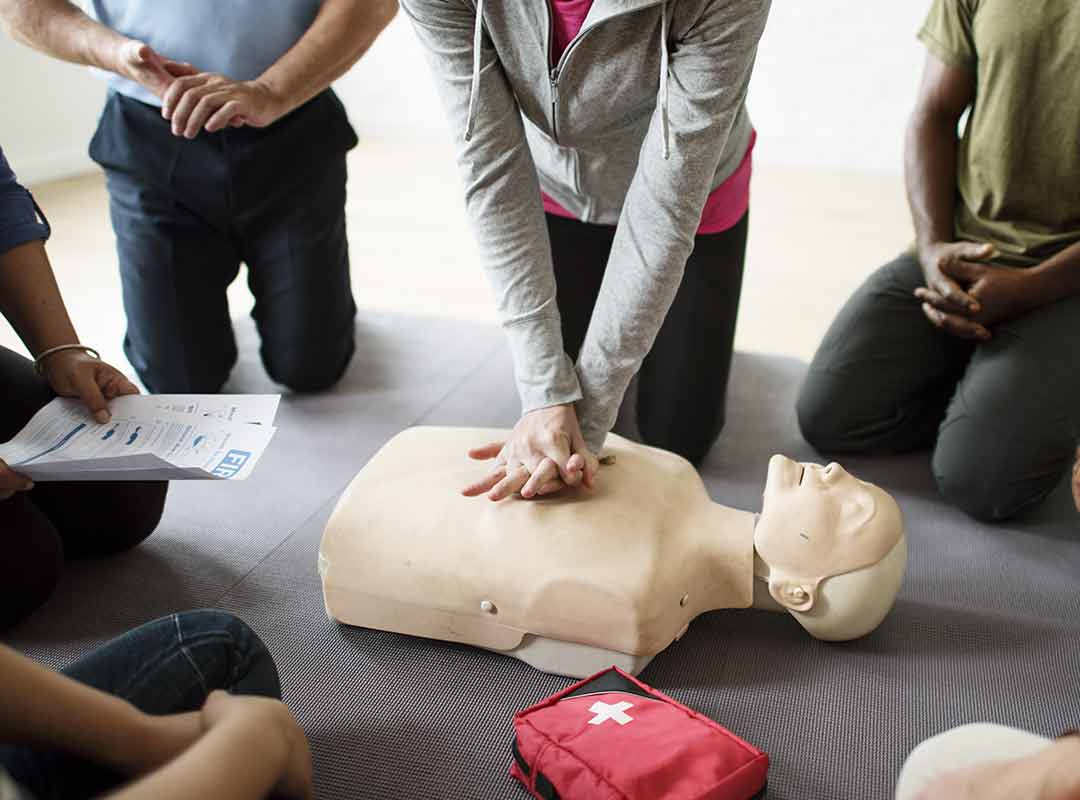Contents
- 1 The Importance of First Aid & CPR Certification
- 2 Basic First Aid Techniques Everyone Should Know
- 3 Cardiopulmonary Resuscitation (CPR) Explained
- 4 Understanding the Chain of Survival
- 5 Types of First Aid & CPR Certifications
- 5.1 Basic First Aid Certification
- 5.2 Professional First Aid Certification
- 5.3 Basic Life Support (BLS) Certification
- 5.4 Cardiopulmonary Resuscitation (CPR) Certification
- 5.5 Advanced Cardiac Life Support (ACLS) Certification
- 5.6 Pediatric Advanced Life Support (PALS) Certification
- 5.7 Choosing the Right Certification
- 6 Where to Obtain First Aid & CPR Certification
- 7 Benefits of First Aid & CPR Certification in the Workplace
- 8 Maintaining First Aid & CPR Skills: The Importance of Recertification
- 9 Real-Life Stories: How First Aid & CPR Certification Saved Lives
- 9.1 Case Study 1: Swift Action During a Cardiac Arrest
- 9.2 Case Study 2: A Lifeguard’s Quick Response
- 9.3 Case Study 3: First Aid Intervention for a Severe Allergic Reaction
- 9.4 Case Study 4: CPR Saves a Co-worker’s Life
- 9.5 Case Study 5: A Teacher’s Intervention for a Choking Student
- 9.6 These real-life stories serve as powerful reminders of the importance of first aid and CPR certification. They showcase how the knowledge, skills, and quick response of certified individuals have made a significant impact in life-or-death situations. By obtaining certification and staying prepared, anyone can become a potential lifesaver and contribute to the well-being of their community or workplace.
- 10 Making a Difference: Spreading Awareness and Encouraging Certification
Are you prepared to handle emergency situations and potentially save lives? Obtaining a first aid and CPR certification is a crucial step towards equipping yourself with life-saving skills. In this comprehensive guide, we will dive into the essentials of first aid and CPR, providing you with the knowledge and confidence to handle emergencies with precision and effectiveness. Whether you’re a concerned parent, a healthcare professional, or simply looking to be prepared for unexpected situations, this article will serve as your go-to resource for understanding the importance of first aid and CPR certification.
The Importance of First Aid & CPR Certification
Why is First Aid & CPR Certification Essential?
First aid and CPR certification is not just a formality; it is a vital skill set that can make a significant difference in emergency situations. By obtaining certification, individuals gain the knowledge and confidence to effectively respond to medical emergencies, potentially saving lives. Whether it’s a minor incident or a life-threatening event, being equipped with the right skills can mean the difference between life and death.
The Potential Impact of Timely Intervention
During emergencies, time is of the essence. Prompt and appropriate first aid and CPR can significantly improve the chances of survival and minimize the risk of complications. By acting swiftly and efficiently, individuals with certification can provide immediate care and stabilize the patient until professional medical help arrives.
Empowering Individuals to Make a Difference
First aid and CPR certification empowers individuals to take control in emergency situations. It provides them with the necessary knowledge and skills to assess the situation, make informed decisions, and administer appropriate care. Having certification not only increases personal confidence but also enables individuals to be a valuable asset in their communities, workplaces, or even at home.
Building a Safer and Prepared Society
By encouraging widespread first aid and CPR certification, we can build a safer and more prepared society. With more individuals trained in life-saving techniques, the likelihood of immediate assistance during emergencies increases significantly. This collective effort can help reduce the impact of accidents and medical emergencies, creating a safer environment for everyone.
Meeting Legal Requirements and Professional Expectations
In some professions, first aid and CPR certification is a mandatory requirement. Healthcare professionals, lifeguards, teachers, and childcare providers are just a few examples of individuals who must possess certification due to the nature of their work. Moreover, many organizations prioritize employees with first aid and CPR certification, as it demonstrates their commitment to safety and preparedness.
Continual Learning and Skill Development
Obtaining first aid and CPR certification is not a one-time achievement. It is an ongoing process that encourages continual learning and skill development. By staying up-to-date with the latest techniques and guidelines through recertification courses, individuals can ensure that their skills are current and effective. This commitment to lifelong learning ensures that individuals are always prepared to handle emergencies.
Basic First Aid Techniques Everyone Should Know
Treating Minor Wounds and Burns
Minor wounds and burns are common occurrences that can happen at home, workplace, or during recreational activities. Knowing how to clean and dress wounds properly can prevent infection and aid in the healing process. Understanding the appropriate steps to take when faced with minor burns, including cooling the burn with running water and applying a sterile dressing, can help alleviate pain and reduce the risk of complications.
Managing Fractures and Sprains
Fractures and sprains can happen unexpectedly, and knowing the initial steps to take can provide comfort and support to the injured individual. Recognizing the signs of a fracture or sprain, immobilizing the injured area with splints or slings, and seeking medical attention promptly are crucial in minimizing further damage and ensuring proper healing.
Dealing with Choking and Airway Obstruction
Choking and airway obstruction can be life-threatening situations that require immediate action. Understanding the Heimlich maneuver or abdominal thrusts for conscious individuals and the appropriate steps for performing CPR on an unconscious person can save lives. By being familiar with these techniques, individuals can confidently intervene during choking emergencies until professional medical assistance arrives.
Providing Assistance for Allergic Reactions
Allergic reactions, whether mild or severe, can escalate quickly and require prompt intervention. Recognizing the symptoms of an allergic reaction, administering an epinephrine auto-injector when necessary, and seeking medical help are vital steps in managing allergic reactions effectively. Knowing how to support and comfort someone experiencing an allergic reaction can provide reassurance and potentially prevent complications.
Responding to Heart Attacks and Strokes
Heart attacks and strokes are medical emergencies that require immediate attention. Recognizing the signs and symptoms, such as chest pain, shortness of breath, or sudden weakness or numbness, is crucial in initiating appropriate care. Understanding how to perform CPR and the importance of early defibrillation with an automated external defibrillator (AED) can significantly increase survival rates and minimize long-term complications.
Assisting in Seizure Situations
Seizures can be distressing for both the individual experiencing them and those witnessing them. Knowing how to create a safe environment by clearing nearby objects, cushioning the person’s head, and timing the seizure can help in assessing the situation and providing necessary information to medical professionals. Offering comfort and support during and after a seizure can also make a difference in the overall experience for the individual affected.
Cardiopulmonary Resuscitation (CPR) Explained
The Science Behind CPR
Cardiopulmonary Resuscitation (CPR) is a life-saving technique that combines chest compressions and rescue breaths to maintain blood flow and oxygenation to vital organs when someone’s breathing or heartbeat has stopped. By manually compressing the chest, CPR helps circulate oxygenated blood throughout the body, providing a temporary solution until professional medical help arrives.
Components of CPR
CPR consists of two main components: chest compressions and rescue breaths. Chest compressions involve pressing on the center of the person’s chest at a consistent rate and depth to simulate the heartbeat and circulate blood. Rescue breaths involve giving breaths into the person’s mouth or nose to deliver oxygen to the lungs. These components work together to maintain oxygen supply to the body and support vital organ function.
Importance of Proper Training
Proper training is essential to perform CPR effectively. Certified instructors provide hands-on training, teaching individuals the correct technique, compression rate, and depth to achieve optimal results. Training also includes recognizing signs of cardiac arrest, activating emergency medical services, and operating automated external defibrillators (AEDs) when available. By obtaining proper training, individuals gain the knowledge and confidence to administer CPR correctly in emergency situations.
Applying CPR on Different Age Groups
CPR techniques may vary depending on the age group of the person in need. For infants, CPR involves using two fingers to perform chest compressions and giving gentle breaths. Children and adults require the use of both hands for chest compressions and rescue breaths. Knowing the proper techniques and adaptations for different age groups is crucial to provide effective CPR and increase the chances of survival.
Hands-Only CPR
Hands-only CPR is an alternative technique recommended for individuals who are untrained or uncomfortable giving rescue breaths. It involves performing continuous chest compressions without providing rescue breaths. Hands-only CPR can still be effective in maintaining blood circulation until professional help arrives. However, it is important to note that rescue breaths are still essential for certain situations, such as drowning or drug overdose cases.
Continuous Learning and Skill Refinement
CPR guidelines and techniques may evolve over time, and it is crucial to stay updated with the latest recommendations. Regularly attending CPR refresher courses or recertification programs helps individuals stay informed about any changes in guidelines and allows for skill refinement. Continuous learning ensures that individuals are equipped with the most up-to-date knowledge and techniques to provide effective CPR in emergency situations.
Understanding the Chain of Survival
Early Recognition of an Emergency
The chain of survival is a concept that emphasizes the critical steps needed to increase the chances of survival during an emergency. The first link in the chain is early recognition of an emergency. Being able to recognize the signs and symptoms of a medical emergency promptly allows for quick intervention and timely assistance.
Activating Emergency Medical Services (EMS)
Once an emergency is recognized, activating emergency medical services is crucial. Dialing the emergency number (such as 911) immediately ensures that trained professionals are on their way to the scene. Promptly providing important details about the situation and following instructions from the dispatcher can help expedite the arrival of medical assistance.
Performing Cardiopulmonary Resuscitation (CPR)
If someone is in cardiac arrest, initiating CPR is the next crucial step in the chain of survival. By performing chest compressions and rescue breaths, CPR helps maintain blood circulation and oxygenation until professional medical help arrives. Properly administering CPR increases the chances of restoring a normal heart rhythm and improving the overall outcome.
Early Defibrillation with an Automated External Defibrillator (AED)
Early defibrillation is a critical link in the chain of survival, especially for individuals experiencing sudden cardiac arrest. An automated external defibrillator (AED) delivers an electric shock to the heart, potentially restoring a normal heart rhythm. Immediate access to an AED and early defibrillation significantly increases the chances of survival and a positive outcome.
Accessing Advanced Care and Post-Resuscitation Care
After the initial steps of recognition, activation of EMS, CPR, and defibrillation, accessing advanced care is essential. Once professional medical help arrives, trained healthcare providers take over and provide advanced life support. Post-resuscitation care focuses on stabilizing the patient, identifying the underlying cause of the emergency, and providing appropriate medical intervention.
The Importance of Each Link
Each link in the chain of survival plays a vital role in improving the chances of survival during an emergency. Early recognition ensures timely intervention, activating EMS ensures professional help is on the way, performing CPR maintains blood circulation, early defibrillation restores a normal heart rhythm, and accessing advanced care provides specialized medical attention. Understanding the importance of each link emphasizes the need for individuals to be trained in first aid, CPR, and AED use.
Types of First Aid & CPR Certifications
Basic First Aid Certification
A basic first aid certification provides individuals with essential knowledge and skills to handle common emergencies. This certification covers topics such as wound care, burns, fractures, choking, and basic life support. It is suitable for individuals who want a general understanding of first aid techniques and are not necessarily seeking professional-level certification.
Professional First Aid Certification
Professional first aid certification is designed for individuals working in specific industries or professions that require a higher level of expertise. This certification may be necessary for healthcare professionals, lifeguards, teachers, childcare providers, or individuals working in high-risk environments. It covers a broader range of topics, including advanced wound care, trauma management, and specialized techniques for specific situations.
Basic Life Support (BLS) Certification
Basic Life Support (BLS) certification is focused on providing individuals with the skills necessary to perform CPR and use an automated external defibrillator (AED). This certification is often required for healthcare professionals, such as nurses, doctors, and emergency responders. BLS certification emphasizes the importance of prompt and effective intervention in cardiac arrest and other life-threatening situations.
Cardiopulmonary Resuscitation (CPR) Certification
CPR certification is specifically focused on teaching individuals the proper techniques and procedures for performing CPR. This certification is suitable for anyone interested in learning how to administer CPR correctly, regardless of their profession or industry. CPR certification typically covers both adult and pediatric CPR, as well as the use of AEDs.
Advanced Cardiac Life Support (ACLS) Certification
Advanced Cardiac Life Support (ACLS) certification is designed for healthcare professionals who may be involved in managing cardiac emergencies or providing critical care. ACLS certification builds upon BLS certification and covers advanced techniques for managing cardiac arrest, stroke, and other life-threatening conditions. ACLS certification often includes training on advanced airway management, pharmacology, and team dynamics during resuscitation efforts.
Pediatric Advanced Life Support (PALS) Certification
Pediatric Advanced Life Support (PALS) certification is geared towards healthcare professionals who work closely with pediatric patients, such as pediatricians, pediatric nurses, and emergency medical personnel. PALS certification focuses on providing specialized care for infants and children in emergency situations, including advanced pediatric life support techniques and algorithms.
Choosing the Right Certification
When selecting a first aid and CPR certification, it’s important to consider your specific needs and requirements. Evaluate the industry or profession you are in, the level of expertise needed, and any legal or workplace requirements. By choosing the right certification, you can ensure that you receive the training necessary to confidently handle emergencies in your line of work or personal life.
Where to Obtain First Aid & CPR Certification
Local Organizations and Community Centers
Local organizations and community centers often offer first aid and CPR certification courses. These courses may be conducted by certified instructors who provide hands-on training and practical demonstrations. Check with your local Red Cross chapter, fire department, or community center to inquire about upcoming certification courses and registration details.
Online Certification Programs
Online certification programs provide a convenient option for individuals who prefer self-paced learning or have scheduling constraints. These programs typically offer interactive modules, videos, and quizzes to ensure comprehension of the material. It is important to choose reputable online certification providers that follow recognized guidelines and provide proper accreditation upon completion.
Hospitals and Healthcare Facilities
Hospitals and healthcare facilities often offer first aid and CPR certification courses for their employees. They may also allow external participants to join these courses for a fee. Contact the training or human resources department of local hospitals or healthcare facilities to inquire about available certification courses and any prerequisites for enrollment.
Workplace Training Programs
Some workplaces provide first aid and CPR training programs for their employees as part of their commitment to safety and preparedness. These training programs may be conducted by certified instructors or external training providers. Check with your employer or human resources department to see if they offer such programs and how you can participate.
Professional Associations and Trade Organizations
Professional associations and trade organizations related to your industry may offer first aid and CPR certification courses. These organizations often tailor their training programs to the specific needs and requirements of professionals in that field. Explore the websites or contact the associations and organizations relevant to your industry to find out if they provide certification courses or can direct you to reputable training providers.
College and University Programs
Many colleges and universities offer first aid and CPR certification courses as part of their health sciences or nursing programs. These courses are often open to both students and the general public. Check the course catalogs or contact the continuing education department of local colleges and universities to inquire about available certification courses and enrollment procedures.
Choosing the Right Certification Provider
When selecting a first aid and CPR certification provider, consider factors such as accreditation, instructor qualifications, course content, and cost. Look for providers that follow recognized guidelines, have experienced instructors, cover the necessary topics, and offer competitive pricing. It is also beneficial to read reviews or seek recommendations from others who have completed certification programs.
Benefits of First Aid & CPR Certification in the Workplace
Creating a Safer Work Environment
First aid and CPR certification in the workplace contribute to a safer environment for employees and customers alike. By having trained individuals on-site, the response time to emergencies can be significantly reduced, potentially preventing further injuries or complications. The presence of certified employees also promotes a sense of security and reassurance among staff members.
Meeting Legal Requirements
In some industries, having employees with first aid and CPR certification is a legal requirement. Regulatory bodies may mandate specific certifications for workplaces to ensure the safety and well-being of employees and customers. By obtaining the necessary certifications, businesses can comply with legal obligations and avoid penalties or legal issues.
Reducing Response Time during Emergencies
During medical emergencies, every second counts. Trained employees with first aid and CPR certification can provide immediate assistance while waiting for professional medical help to arrive. Their quick response and knowledge of life-saving techniques can make a significant difference in stabilizing the situation and improving the chances of a positive outcome.
Enhancing Employee Confidence and Morale
Providing first aid and CPR certification opportunities to employees can boost their confidence and morale. Knowing that they possess life-saving skills can empower individuals and increase their sense of value within the workplace. This empowerment can lead to higher job satisfaction, improved teamwork, and a positive working environment.
Preparing for Unexpected Situations
Emergencies can happen at any time, and being prepared is crucial. Having a workforce equipped with first aid and CPR certification ensures that there are trained individuals available to handle unexpected situations. This level of preparedness minimizes panic, reduces the impact of emergencies, and increases overall workplace safety.
Building a Positive Company Image
Companies that prioritize employee safety and invest in first aid and CPR certification demonstrate their commitment to the well-being of their workforce and customers. This emphasis on safety can enhance the company’s reputation, attract quality employees, and build trust among clients and stakeholders. A positive company image can lead to increased business opportunities and sustained growth.
Providing a Competitive Edge
Businesses that have a higher percentage of employees with first aid and CPR certification may gain a competitive edge. Clients and customers may prefer to work with or patronize companies that prioritize safety and have trained staff members who can handle emergencies effectively. This advantage can differentiate a business from its competitors and contribute to its success.
Maintaining First Aid & CPR Skills: The Importance of Recertification
Skills Deteriorate Over Time
It is important to recognize that skills in first aid and CPR can deteriorate over time. Without regular practice and reinforcement, individuals may forget certain techniques or become less confident in their abilities. By undergoing recertification, individuals can refresh their knowledge, refine their skills, and ensure they are up-to-date with the latest guidelines and protocols.
Recommended Recertification Frequency
The frequency of recertification depends on the certification provider and industry standards. Generally, it is recommended to renew first aid and CPR certifications every two to three years. However, certain professions or workplaces may have specific requirements that necessitate more frequent recertification. It is important to check with the certification provider or regulatory bodies to determine the recommended recertification timeline.
Staying Updated with Guidelines and Best Practices
Guidelines and best practices in first aid and CPR can evolve over time as new research and advancements emerge. Recertification courses ensure that individuals are aware of any updates or changes in protocols. Staying informed about the latest guidelines ensures that individuals are equipped with the most effective techniques and can provide the best possible care in emergency situations.
Reviewing and Practicing Skills
Recertification courses provide an opportunity for individuals to review and practice their first aid and CPR skills. These courses typically involve hands-on training sessions where participants can refresh their memory on proper techniques, perform mock scenarios, and receive feedback from instructors. This hands-on practice helps individuals regain confidence and reinforce muscle memory for critical procedures.
Learning New Techniques and Advances
Recertification courses often introduce new techniques and advances in first aid and CPR. These updates may include changes in the sequence of steps, modifications to existing techniques, or the introduction of new equipment. By undergoing recertification, individuals can stay abreast of these developments and ensure that they are equipped with the most effective tools and knowledge to respond to emergencies.
Meeting Workplace or Regulatory Requirements
Some workplaces or regulatory bodies may require employees to maintain valid and up-to-date first aid and CPR certification. By undergoing recertification, individuals fulfill these requirements and remain compliant with workplace regulations or industry standards. This ensures that individuals can continue to perform their jobs effectively and contribute to a safe and prepared work environment.
Commitment to Lifelong Learning
Recertification is not just about maintaining certification status; it is a commitment to lifelong learning and continuous improvement. By actively seeking recertification, individuals demonstrate their dedication to staying knowledgeable, competent, and prepared to respond to emergencies. This commitment to ongoing education and skill development establishes a culture of safety and professionalism.
Real-Life Stories: How First Aid & CPR Certification Saved Lives
Case Study 1: Swift Action During a Cardiac Arrest
In a crowded shopping mall, a man suddenly collapsed and stopped breathing. Luckily, a passerby trained in CPR immediately recognized the emergency, started chest compressions, and directed someone to call for help. By the time paramedics arrived, the man’s pulse had been restored, and he was breathing on his own. The quick response and effective CPR performed by the certified individual played a crucial role in saving his life.
Case Study 2: A Lifeguard’s Quick Response
At a busy pool, a child was found unconscious in the water. The lifeguard on duty, who had received comprehensive first aid and CPR training, quickly pulled the child out of the pool and assessed the situation. Recognizing the signs of drowning and lack of breathing, the lifeguard immediately initiated CPR. Within minutes, the child started breathing again and regained consciousness. The lifeguard’s swift response and proper application of life-saving techniques prevented a tragedy from occurring.
Case Study 3: First Aid Intervention for a Severe Allergic Reaction
During a school field trip, a student with a known severe allergy accidentally ingested an allergen. A teacher, who had undergone first aid and CPR training, recognized the signs of an allergic reaction and administered an epinephrine auto-injector from the student’s emergency kit. The quick administration of epinephrine helped to stabilize the student’s condition while waiting for emergency medical services to arrive. The teacher’s knowledge and prompt intervention prevented a potentially life-threatening situation.
Case Study 4: CPR Saves a Co-worker’s Life
During a team meeting, a co-worker suddenly collapsed and became unresponsive. Another employee, who had recently completed a CPR certification course, immediately initiated chest compressions while someone else called for an ambulance. The quick response and effective CPR provided continuous blood flow until the paramedics arrived and took over. The co-worker survived the cardiac event and made a full recovery, thanks to the certified employee’s life-saving actions.
Case Study 5: A Teacher’s Intervention for a Choking Student
During lunchtime at a school cafeteria, a student started choking on a piece of food. The teacher on duty, who had received first aid training, quickly assessed the situation and performed abdominal thrusts to dislodge the obstruction. Within seconds, the student was able to breathe again. The teacher’s knowledge and immediate action prevented an airway obstruction from turning into a serious medical emergency.
These real-life stories serve as powerful reminders of the importance of first aid and CPR certification. They showcase how the knowledge, skills, and quick response of certified individuals have made a significant impact in life-or-death situations. By obtaining certification and staying prepared, anyone can become a potential lifesaver and contribute to the well-being of their community or workplace.
Making a Difference: Spreading Awareness and Encouraging Certification
Sharing the Importance of First Aid & CPR Certification
One way to make a difference is by spreading awareness about the importance of first aid and CPR certification. Utilize various platforms such as social media, community forums, or workplace newsletters to share information about the benefits of certification, real-life success stories, and statistics highlighting the impact of timely intervention. By educating others, you can inspire them to consider getting certified and empower them to make a positive difference in emergency situations.
Encouraging Workplace Certification Programs
If you are an employer or have influence within your workplace, consider advocating for workplace certification programs. Highlight the benefits of having certified employees, such as increased safety, reduced response time during emergencies, and compliance with legal requirements. Encourage management to provide resources and support for employees to obtain or renew their first aid and CPR certifications. By creating a culture of preparedness, you can contribute to a safer and more proactive work environment.
Organizing Community Certification Drives
Collaborate with local organizations, schools, or community centers to organize certification drives or workshops. Work with certified instructors or training providers to offer discounted or free certification courses to community members. Promote these events through community bulletin boards, local newspapers, or online platforms to reach a wider audience. By making certification more accessible and affordable, you can empower individuals to gain life-saving skills and create a more prepared community.
Becoming a Certified Instructor
If you are passionate about first aid and CPR, consider becoming a certified instructor yourself. By obtaining instructor-level certification, you can teach and empower others with life-saving skills. Offer certification courses at local organizations, schools, or community centers. Share your knowledge and experiences, and inspire others to become certified and make a difference in their own communities. As an instructor, you can contribute to the spread of life-saving skills and create a network of certified individuals.
Supporting Nonprofit Organizations
Nonprofit organizations dedicated to promoting first aid and CPR certification often rely on donations and volunteers to carry out their mission. Consider supporting these organizations through monetary donations, volunteering your time, or participating in fundraising events. By contributing to their efforts, you can help them reach more individuals, provide resources, and offer training opportunities to underserved communities. Your support can make a significant impact in spreading awareness and encouraging certification on a larger scale.
Conclusion
Spreading awareness about the importance of first aid and CPR certification and encouraging others to become certified are powerful ways to make a difference. By taking proactive steps to promote certification, you can empower individuals with life-saving skills, contribute to safer communities, and increase the chances of positive outcomes during emergencies. Together, we can create a society that is prepared, knowledgeable, and ready to save lives.
In conclusion, obtaining first aid and CPR certification is a crucial step towards being prepared for emergency situations and potentially saving lives. By obtaining certification, individuals gain the knowledge, skills, and confidence to respond effectively in critical situations. From providing immediate care during an incident to performing life-saving techniques like CPR, being certified empowers individuals to make a positive impact on their communities and workplaces.
Throughout this article, we explored the importance of first aid and CPR certification, the essential techniques everyone should know, the science behind CPR, and the different types of certifications available. We also discussed the significance of recertification to maintain skills, real-life stories showcasing the impact of certification, and ways to spread awareness and encourage others to become certified.
Remember, first aid and CPR certification is not just a formality; it is a commitment to preparedness, lifelong learning, and making a difference. Whether you are a concerned parent, a healthcare professional, or an individual looking to enhance your skills, obtaining certification equips you with the tools to respond effectively in emergencies. By taking the initiative to become certified and encouraging others to do the same, we can create a safer, more prepared society where more lives can be saved.

Passionate about preserving lives and protecting properties, John Sarver is a dedicated advocate for fire safety. With an unwavering commitment to educating and empowering communities, he has become a prominent voice in the field. As the founder and author of the influential blog “SarverFire,” John’s mission is to share invaluable insights, tips, and resources to enhance fire safety awareness and preparedness.





